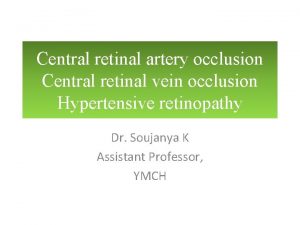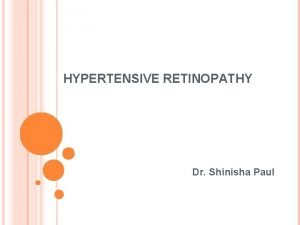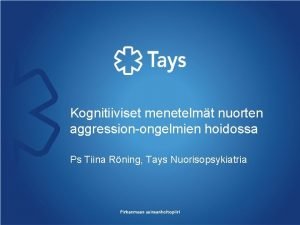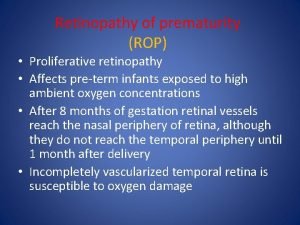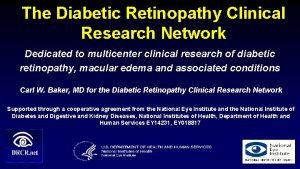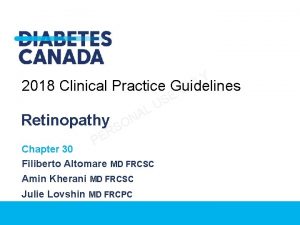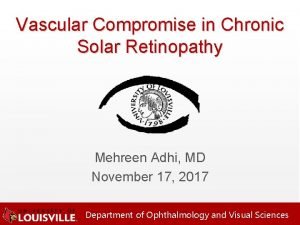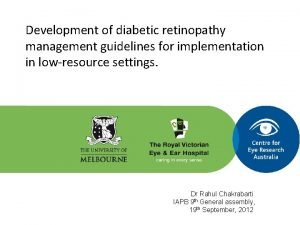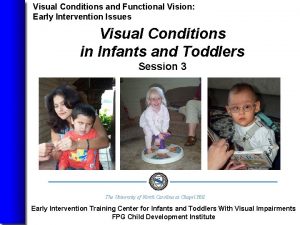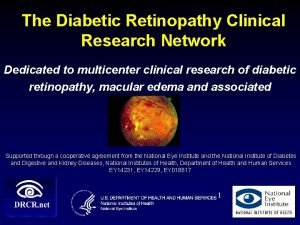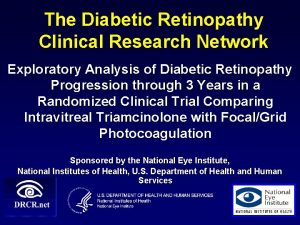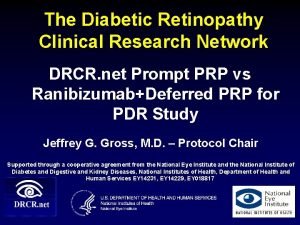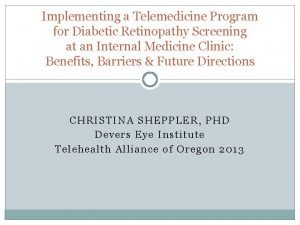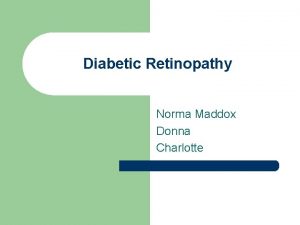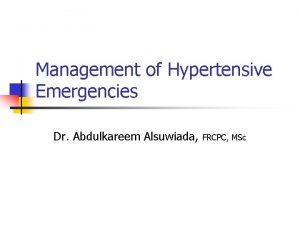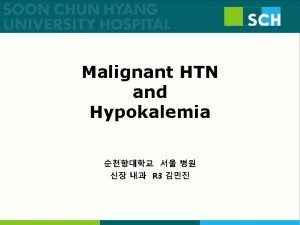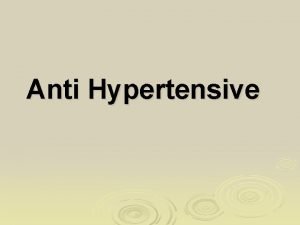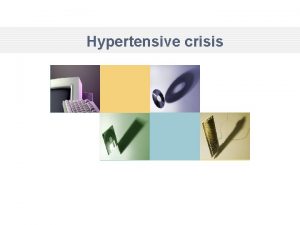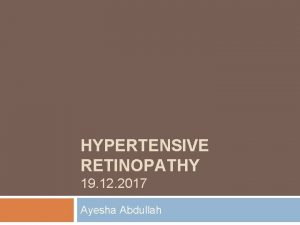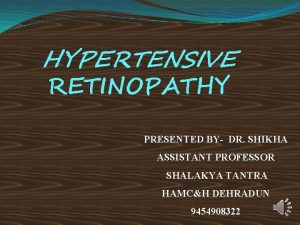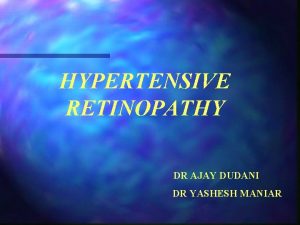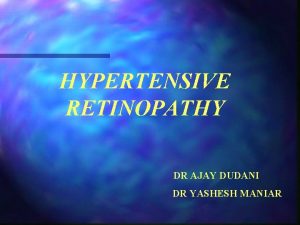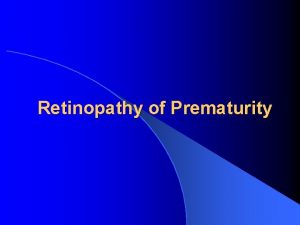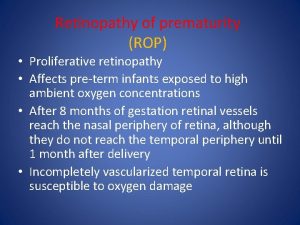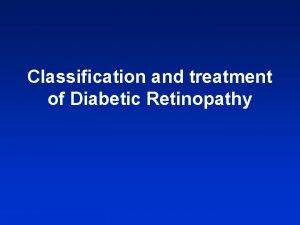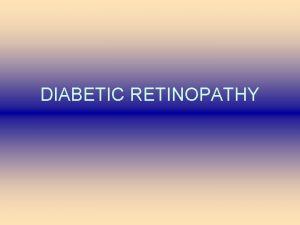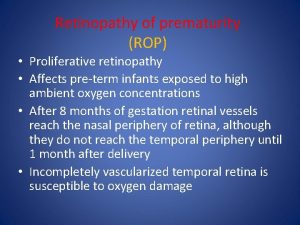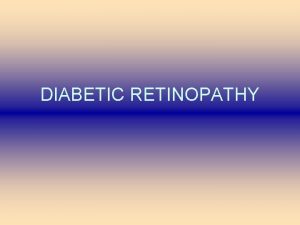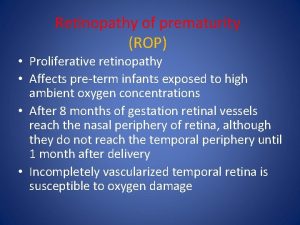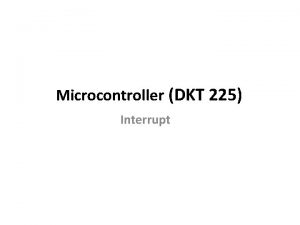Update on Hypertensive Retinopathy Dkt Muchai Gachago Introduction





















- Slides: 21

Update on Hypertensive Retinopathy Dkt. Muchai Gachago

Introduction • First described in the late 1800 s • Used to predict risk of stroke, cardiovascular disease, and even mortality Epidemiology • HR in 3% to 14% of nondiabetic adults age ≥ 40. • 10 year cumulative incidence is 16%.

PATHOGENESIS AND PRESENTATION • spectrum of “retinal vascular signs” caused by elevated blood pressure. • Autoregulation of the vasculature → breakdown of autoregulation pathways and atherosclerosis

Signs

Signs

Signs

Signs

Signs

Long-term Consequences • Arteriolosclerosis - irreversible→opacification, compression of venules. • BRB disruption→“exudative” stage • “Malignant” stage → optic disc and macular oedema due to raised intracranial pressure.

Keith–Wagener–Barker Classification Grade Features 1 Mild generalized retinal arteriolar narrowing 2 Definite focal narrowing and arteriovenous nipping 3 Signs of grade 2 retinopathy plus retinal hemorrhages, exudates, and cotton wool spots 4 Severe grade 3 retinopathy plus papilloedema -Poor reliability and reproducibility -Grades do not correlate with severity of hypertension -Not sequential in nature -Grades do not correlate with prognosis, cardiovascular events, and mortality.

Simplified Classification Grade Mild ( retinal arteriolar signs) Moderate (retinopath y-like lesions) Malignant Features Generalized arteriolar narrowing, focal arteriolar narrowing, arteriovenous nicking, opacity (“copper wiring”) of arteriolar wall, or a combination of these signs Retinal hemorrhages (blot-shaped, dot-shaped, or fiame-shaped), microaneurysms, cotton wool spots, hard exudates, or a combination of these signs Signs of moderate retinopathy plus optic disk swelling -Good reliability and reproducibility. -Predicted the long-term risk of stroke. -Ease of use -Appropriate stratification of cardiovascular risk disease.

Recent Observations • ↑blood pressure →higher frequency of retinopathy signs • Long-term hypertension → Generalized retinal arteriolar narrowing & AVN. Assoc with ↑BP control in past 10 yrs • Focal arteriolar narrowing and retinopathy lesions related only to concurrently measured blood pressure. • Assoc between BP and retinal microvascular signs ↓with age • Smaller retinal arteriolar and larger venular calibers precede clinical stages of hypertension and predict the risk of hypertension in initially normotensive individuals.

RELATIONSHIP WITH TARGET ORGAN DAMAGE Atherosclerosis Risk in Communities (ARIC) study, subjects with HR: • ↑ risk of developing incident stroke • Cognitive decline • Cerebral white matter lesions • Cerebral atrophy • Predicted the long-term risk of stroke • Incident stroke (19. 3% vs 4. 3%) and incident cerebral infarction (15. 5% vs 3. 6%)

Kidney and Heart Disease • ↑Chronic kidney disease (CKD) & microalbuminuria • Stroke * 7 • Heart attack * 4 • Coronary artery disease * 3 • Peripheral artery disease * 2

CLINICAL MANAGEMENT Retinopathy Grade Mild Systemic Associations Weak associations with stroke, coronary heart disease and cardiovascular mortality Moderate Strong association with stroke, congestive heart failure, renal dysfunction, and cardiovascular mortality Malignant Associated with mortality Management Routine care Closer monitoring of vascular risk Exclude diabetes Closer monitoring of vascular risk Possible indication for hypertension treatment and other risk factors Urgent hypertension treatment

Hypertensive Choroidopathy Elschnig Spots: Focal choroidal infarcts Exudative RD Siegrist Streaks: Fibrinoid necrosis

Complications

Complications

Complications


Further Reading • Retinal Physician, Volume: 10 , Issue: November 2013, page(s): 43 – 54. . . Review Article Reviewing 96 papers on Hypertension and HR.
 Retina silver wiring
Retina silver wiring Modified scheie classification of hypertensive retinopathy
Modified scheie classification of hypertensive retinopathy Dkt taidot
Dkt taidot What does id card mld mean
What does id card mld mean Which is an alternative of log based recovery
Which is an alternative of log based recovery Stages of retinopathy of prematurity
Stages of retinopathy of prematurity Albany diabetic retinopathy
Albany diabetic retinopathy Diabetic retinopathy clinical research network
Diabetic retinopathy clinical research network Diabetic retinopathy cpg
Diabetic retinopathy cpg Solar retinopathy
Solar retinopathy Diabetic retinopathy grading
Diabetic retinopathy grading Diabetic retinopathy
Diabetic retinopathy Eibschitz-tsimhoni
Eibschitz-tsimhoni Diabetic retinopathy clinical research network
Diabetic retinopathy clinical research network Diabetic retinopathy clinical research network
Diabetic retinopathy clinical research network Diabetic retinopathy clinical research network
Diabetic retinopathy clinical research network Drcr net
Drcr net Diabetic retinopathy clinical research network
Diabetic retinopathy clinical research network Diabetic retinopathy screening reimbursement
Diabetic retinopathy screening reimbursement Diabetic retinopathy charlotte nc
Diabetic retinopathy charlotte nc Urgency hypertension
Urgency hypertension Malignant hypertension treatment
Malignant hypertension treatment
